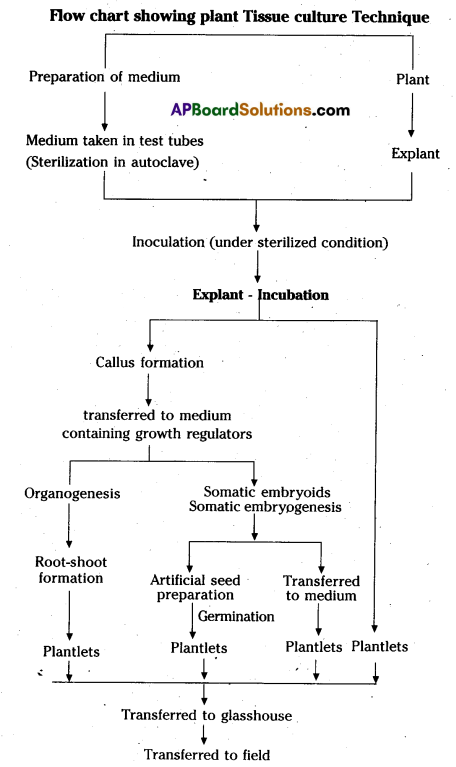Thoroughly analyzing AP Inter 2nd Year Botany Model Papers and AP Inter 2nd Year Botany Question Paper March 2017 helps students identify their strengths and weaknesses.
AP Inter 2nd Year Botany Question Paper March 2017
Time: 3 Hours
Max. Marks: 60
Note: Read the following instructions carefully:
- Answer all questions of Section ‘A’. Answer any six questions out of eight in Section ‘B’ and answer any two questions out of three in Section ‘C’.
- In Section A’, questions from Sr. Nos. 1 to 10 are of Very Short answer Type”. Each question cames two marks. Every answer may be limited to 5 lines. Answer all the questions at one place in the same order.
- In Section B, questions from Sr. Nos. 11 to 18 are of “Short Answer Type”. Each question cames four marks. Every answer may be limited to 20 lines.
- In Section C, questions from Sr. Nos. 19 to 21 are of “Long Answer Type”. Each queštion carries eight marks. Every answer may be limited to 60 lines.
- Draw labelled diagrams wherever necessary for questions in Section ‘B’ and ‘C’.
Section – A
(10 x 2=20 M)
Note: Answer all questions. Each answer may be limited to 5 lines.
Question 1.
Differentiate osmosis from diffusion.
Answer:
| Osmosis | Diffusion |
| The movement of water from low concentrated place to high concentrated place through a semi-permeable membrane is called osmosis. | The movement of gases or molecules from high concentrated place to low concentrated place spontaneously is called diffusion. |
Question 2.
Where does the photolysis of H2O occur? What is its significance?
Answer:
Photolysis of water occurs in the ‘Grana of the chloroplast. It splits into protons, electrons, and oxygen. ¡t creates oxygen, one of the net products of photosynthesis.
Question 3.
What is conjugation? Who discovered it and in which organism?
Answer:
The transfer of genetic material through direct cell-to-cell contract is called conjugation. It was first observed by Lederberg and Tatum in Escherichia coil.
![]()
Question 4.
Who proposed the chromosome theory of inheritance?
Answer:
Walter Sutton and Theodore Boyen proposed chromosome theory of inheritance.
Question 5.
What are components of a nucleotide?
Answer:
Nitrogen base, a sugar molecule and phosphate molecule.
Question 6.
Write any two chemical differences between DNA and RNA.
Answer:
| DNA | RNA |
| 1. Deoxyribose sugar is present. (C5H0O4). | 1. Ribose sugar is present (C5H10O5 ions) |
| 2. Nitrogen bases are Adenine, Guanine, Thymine and cytosine. | 2. Nitrogen bases are Adenine, Guanine, Uracil and cytosine. |
Question 7.
What are molecular scissors? Where are they obtained from?
Answer:
Molecular scissors are the restriction enzymes which cut the DNA at specific sites. They are obtained from Bacteria.
Question 8.
Can a disease be detected before its symptoms appear? Explain the principle involved.
Answer:
Yes, Very low conc. of a bacteria or virus can be detected by amplification of their nucleic acid through PCR, ELISA.
Question 9.
Give two examples of fungi used in SCP production.
Answer:
Candida utilis, Chaetomium cellulolyticum
Question 10.
Name any two industrially important enzymes.
Answer:
Lipases and streptokinase
![]()
Section – B
(6 x 4 = 24 M)
Note: Answer any SIX questions. Each answer may be limited to 20 lines.
Question 11.
“Transpiration is a necessary evil”. Explain.
Answer:
Beneficial effects:
- It helps in passive absorption of water.
- It also helps in passive absorption of mineral salts by mass flow mechanism.
- It is the main force for ascent of sap.
- It regulates the temperature of plant body and provides cooling effect.
- Maintain shape and structure of the plants by keeping cell Turgid.
Harmful Effects:
- Excessive transpiration makes the cells flaccid which retards growth.
- Excessive transpiration leads to closure of stomata thus obstructing gaseous exchange.
Question 12.
Explain the steps involved in the formation of root nodule.
Answer:
- Roots of legumes release sugars and amino acids which attached Rhizobium. They get attached to epidermal and root hair cells of the nos.
- The root hair curl and the bacteria invade the root hair.
- An infection thread produced carrying the bacteria into cortex of the root
- Bacteria initiate nodule formation in the cortex of the root. Then the bacteria released from the thread into the cortical cells of the host and stimulate the host cells to divide. This leads to the differentiation of specialized nitrogen-fixing cells.
- The nodule thus formed establishes a direct vascular connection with the host for exchange of nutrients.
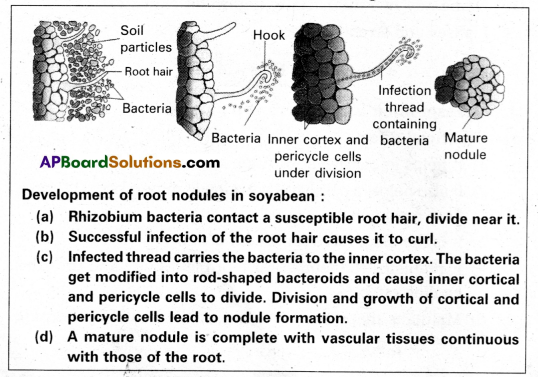
Question 13.
Write briefly about enzyme inhibitors.
Answer:
The chemicals that can shuts off enzyme activity are called enzyme inhibitors. They are of three types.
A. Competitive inhibitors: Substances which closely resemble the substrate molecules and inhibits the activity of the enzyme are called Competitive inhibitors. Ex: Inhibition of Succinic dehydrogenase by Malonate which closely resembles the substrate Succinate.
B. Non-competitive inhibitors: The inhibitors which have no structural similarity with the substrate and bind to an enzyme at locations other than the active sites, so that the globular structure of the enzyme is changed are called Non-competitive inhibitors.
Ex: Metal ions of Copper, Mercury.
C. Feedback inhibitors: The end product of a chain of enzyme catalysed reactions inhibits the enzyme of the first reaction as part of homeostatic control of metabolism is called feedback inhibitors. Ex: During respiration, accumulation of Glucose 6 phosphate occurs, inhibits the Hexokinase.
Question 14.
Write a note on agricultural/horticultural applications of Auxins.
Answer:
- IBA, NAA, and IAA help to initiate rooting in stem cuttings. widely used for plant propagation in horticulture.
- Auxins like 2, 4 – D, 2, 4, 5 – T act as herbicides and kills broad-leaved dicot weeds to prepare weed-free lawns.
- Auxins stimulate fruit growth. Ex: Tomato.
- Auxins induce flowering in pineapple.
- Auxins prevent premature leaf and fruit drop.
![]()
Question 15.
Explain the structure of T-even Bacteriophages.
Answer:
- The viruses which attack bacteria are called Bacteria phages. They were discovered by Twort (1915).
- Felix ‘d’Herelle (1917) coined the term Bacteriophage.
- Bacteriophages are tadpole-shaped with a large head and a tail.
- The head is hexagonal and is capped by hexagonal pyramid, measures about 65 x 95 nm.
- The head is formed with several cap-someres. each of which is a single protein.
- The head protein forms a semipermeable membrane enclosing the folded double-stranded DNA which is 1000 times longer than the phage.
- The tail is composed of several parts present around central core.

Question 16.
Mention the advantages of selecting pea plant for experiment by Mendel.
Answer:
- It is an annual plant that has well-defined characteristics.
- It can be grown and crossed easily.
- It has bisexual flowers containing both male and female parts.
- It can be self-fertilized conveniently.
- It has a short life cycle and produces Large number of offspring.
Question 17.
What are the important features of Genetic code?
Answer:
- The codon is triplet. of 64 codons, 61 codons code for 20 amino acids and 3 codons do not code for any amino acids (stop codons, UAA, UAG, UGA).
- One codon codes for only one amino acid, hence it is unambiguous and specific.
- Some amino acids are coded by more than one codon, hence the code is degenerate
- The codon is read in mRNA in a contiguous fashion. There are no punctuations.
- The code is nearly universal. For Ex: UUU code for phenylalanine (phe) in bacteria and humans.
- AUG code for methionine and also acts as initiator codon. (Dual role).
Question 18.
What are some bio-safety issues concerned with genetically modified crops?
Answer:
- There is fear of transferring allergins or toxins to humans and animals as side effects.
- There is a risk of changing the fundamental nature of vegetables.
- They may pose a harmful effect on biodiversity and have an adverse impact on the environment.
- There is a risk of gene pollution due to the transfer of the new genes into related wild species through natural outcrossing. This results in the fórmation of superweeds and may be resistant to weedicides.
- They may bring about changes in natural evolutionary patterns.
Section – C
(2 x 8 = 16M)
Note: Answer any two questions. Each answer may be limited to 60 lines.
Question 19.
Explain the reactions of Krebs cycle.
Answer:
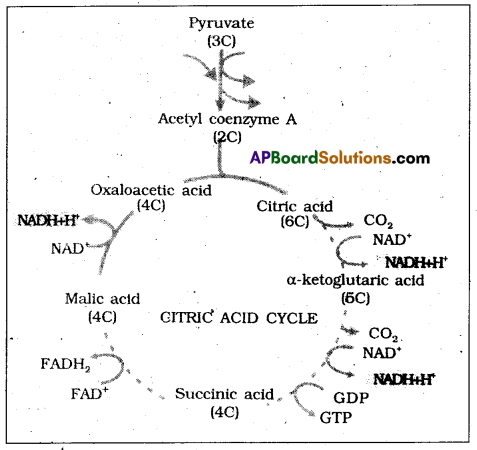
The cetyl CoA eaters into the [mitochondrial matrix a cyclic pathway tricarboxylic acid cycle, more commonly called Krebs cycle after the scientist Hans Krebs who first elucidated it.
1. Condensation: In this acetyl CoA condenses with oxaloacetic acid and water to yield citric acid in the presence of citrate synthetase and CoA is released. :
![]()
2. Dehydration: Citric acid looses water molecule to yield cis aconitic acid in the presence of aconitase.

3. Hydration: A water molecule is added to cisaconic acid to yield isocitric acid in the presence of a conitase.
![]()
4. Oxidation I: Isocitric acid undergoes oxidation in the presence of dehydrogenase to yield succinic acid

5. Decarboxylation: Oxalosuccinic acid undergoes decarboxylation in the presence of decarboxylase to form α-keto glutaric acid.

6. Oxidation II, decarboxylation: α – keto glutaric acid undergoes oxidation and decarboxylation in the presence of dehydrogenase and condenses with co..A to form succinyl Co. A.

7. Cleavage: Succinyl Co.A splits into succinic acid and Co.A in the presence of thiokinase to form succinic acid. The energy released is utilised to from ATP from ADP and PI.

8. Oxidation – III: Succinic acid undergoes oxidation and forms Fumaric acid in the presence of succinic dehydrogenase.

9. Hydration: A water molecule is alcohol to Fumaric acid in the presence of Fumarase to form Malic acid.
![]()
10. Oxidation IV: Malic acid undergoes oxidation in the presence of malic dehydrogenase to form oxaloacetic acid.

In TCA cycle, for every 2 molecules of Acetyl Co.A undergoing oxidation, 2 ATP 8 NADPH+ H+, 2FADH2 molecules are formed.
![]()
Question 20.
Explain briefly the various processes of recombinant technology.
Answer:
The important method in. recombinant DNA technology are performed through genetic engineering.
They are:
- Isolation of a desired gene
- Insertion of an isolated gene into a suitable vector
- Introduction of recombinant vector into a host and
- Selection of the transformed host cells.
I) Isolation of a desired gene:
- The desired gene is isolated from the donor cell. Normally bacteria are the source of desired genes.
- The cell walls of bacteria are degraded with the help of enzymes.
- The cell membranes are lysed with the help of detergents.
- By treating the cellular constituents with phenols and suitable nucleases and by subjecting to gradient centrifugation, pure DNA is isolated.
- The purified DNA is cut into a number of fragments by restriction endonucleases.
- The restriction enzymes cleave DNA molecules in two ways.
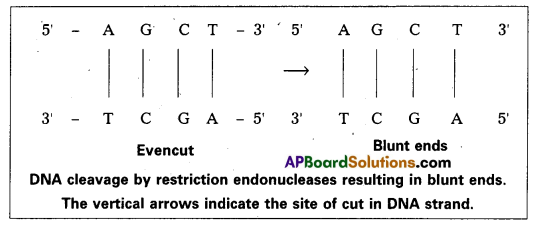
- In one way they cut both strands of DNA at exactly opposite points to each other. This results in DNA fragments with blunt ends or flush ends, where two strands end at the same point. Such cut is generally termed as even cut.
- But commonly, most enzymes cut the two strands of DNA double helix at different locations. Such a cleavage Is generally termed as staggered cut. This generates protruding ends i.e., one strand of DNA double helix extends some bases beyond the other. Since the target site is palindromic in nature, the protruding ends generated by such a cleavage have a complementary base sequence.
As a result, they readily pair with each other and such ends are called cohesive or sticky ends. This stickyness of the ends facilitates the action of the enzyme DNA ligase. When cut by the same restriction enzyme, the resultant DNA fragments have the same kind of ‘sticky ends’ and these can be joined together readily by using DNA ligases.
E.g.: The restriction enzyme E coRI.
E – The first letter, represents the name of genus Escherichia.
Co – The next two letters, represent the species Esche richia CoU.
The letter R is derived from the name of strain.
Roman numbers following the names indicate the order in which the enzymes were isolated from the strain of bacteria. This enzyme specifically recognises GAA sites on the DNA and cuts it between G and A (G ↓, A)

The resultant fragments are separated from each other by gel electrophoresis.
The desired fragments are selected by Southern blotting technique.
II) Insertion of isolated gene into a suitable vector:
- The selected fragments of DNA are inserted into a suitable vector to produce a large number of copies of genes.
- This is called gene cloning.
- There are two major types of vectors, namely plasmids and bacteriophages.
- Among the two types, plasmids are the ideal cloning vectors.
- To isolate a plasmid, the Bacterial cell is treated with EDTA (Ethylene diamine tetra acetic acid) along with lysozyme enzyme to digest the cell wall.
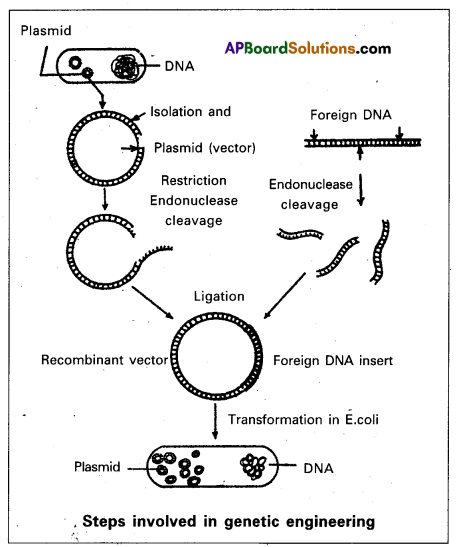
- Then the bacterial cell is subjected to centrifugation in sodium lauryl sulphate to separate the plasmid.
- The plasmid DNA is cut with the help of restriction endonuclease.
- The circular plasmid is converted into a linear molecule having sticky ends.
- The two sticky ends of linear plasmid are joined to the ends of desired gene by DNA ligase.
- The plasmid containing foreign DNA segments is called recombinant DNA (r DNA) or Chimeric DNA.
III) Introduction of recombinant vector into a suitable host:
- The rDNA molecule is introduced into suitable bacterial host cells by transformation.
- The cell containing r DNA is called transformed cell.
- Bacterial cell walls are not permeable to recombinant vectors, but keeping in die. Calcium chloride renders the bacterial cell wall permeable to recombinant vectors.
- The rDNA replicates within the host cell.
- The transformed cell grows on the culture medium. Each nature of gene daughter cell contains r DNA.
IV) Selection of transformed host cells:
- Selection of transformed cells depends on the which is cloned.
- It can be done in two ways.
They are
- Without using probes
- By using probes.
a) Without using probes:
If the gene is cloned for antibiotic resistance, the cells are first incubated on a medium without antibiotic for one hour, to allow the antibiotic resistance gene to be expressed. Then the cells are placed on a medium with an antibiotic for selection of colonies containing rDNA, The cells which have expressed the gene will survive and the others die.
b) By using probes: When transformed cells are cultured on the nutrient medium, several cells are produced. To select the cells containing the desired gene colony hybridization method is used. In this gene specific probes are used. A probe is a small fragment of single-stranded RNA or DNA which is tagged with radioactive, molecule. It can search out complimentary DNA sequences from an organism.
![]()
Question 21.
Describe the tissue culture technique and what are the advantages of tissue culture over conventional method of plant breeding in crop improvement programmes?
Answer:
Tissue culture Technique: It involves
a) Preparation of Nutrient medium: The nutrient medium is a mixture of various essential nutrients, amino acids, vitamins, and carbohydrates. These are mixed in distilled water and pH is adjusted to 5.6 to 6.0. Growth regulators like auxins and cytokinins are added to the medium. The nutrient medium is poured in glass vessels and closed tightly with cotton plugs before sterilizing them in an autoclave.
b) Sterilisation: The nutrient medium is rich in nutrients and therefore attracts the growth of microorganisms. the culture medium is autoclaved for 15 mins, at 120°c or 15 pounds of pressure to make aseptic.
c) Preparation of explant: Any living part of plant can be used as explant. The explants must be cleaned with liquid detergent and in running water and surface steri1ied with sodium hypo chiorité and rinsed with distilled water.
d) Inoculation of explants: The transfer of explants onto the sterilized nutrient medium is called inoculation. It is carried out under stabilized conditions.
e) Incubation: The culture vessels with inoculated explants are incubated in a culture room under controlled temperature, optimum light, and humidity. The cultures are incubated for 3-4 weeks, the cells of the explant divide and redivide, producing a mass of tissue called callus. The callus is transferred to another medium containing growth regulators to initiate the formation of roots and leafy shoots (organogenesis). Sometimes embryo-like structures develop directly from the callus which are referred as somatic embryos. These can be encapsulated with sodium alginate to form synthetic or artificial seeds.
f) Acctamatization and transfer to pots: The plants produced through tissue culture are washed gently and are planted in pots kept in glass house for 1 – 2 weeks. Finally, they are transferred to field.
Advantages:
- The production of exact copies of plants that produce particularly good flowers, fruits or have other desirable traits.
- To quickly produce mature plants.
- The production of multiples of plants in the absence of seeds or necessary pollinators to produce seeds.
- The regeneration of whole plants from plant cells that have been genetically modified.
- The production of plants from seeds that otherwise have very low chances of germinating and growing i.e., orchids and nepenthes.
- To clean particular plants of viral and other infections and to quickly multiply these plants as cleaned stock for Horticulture and Agriculture.
